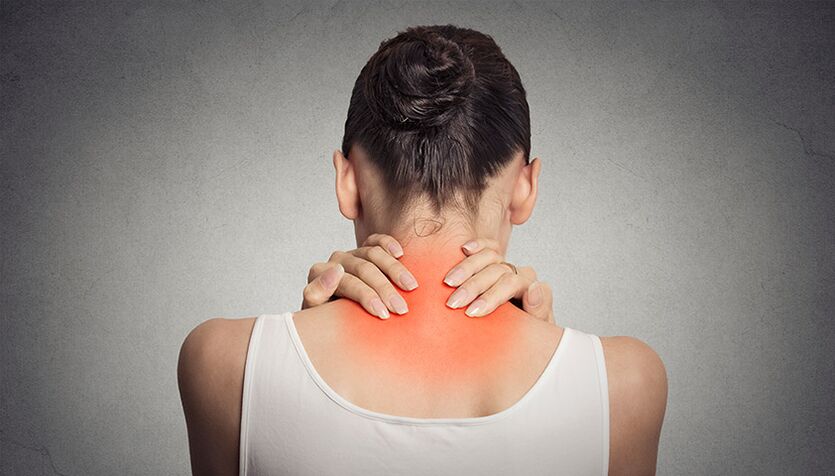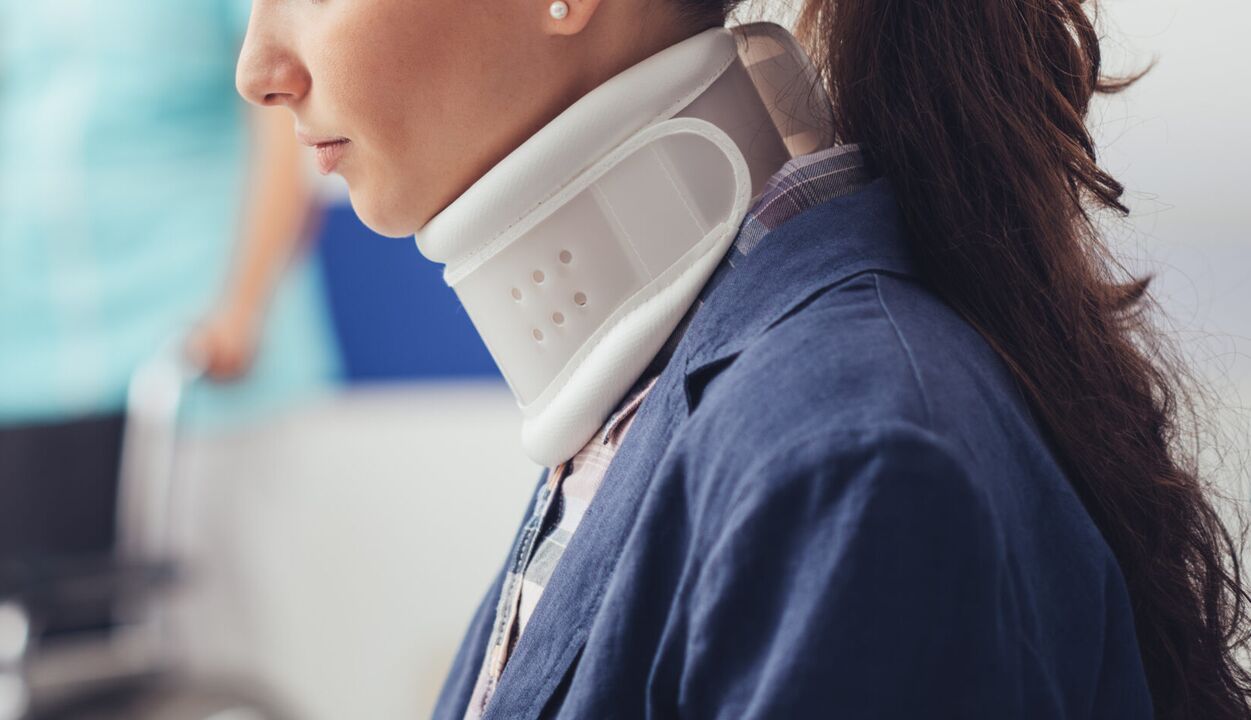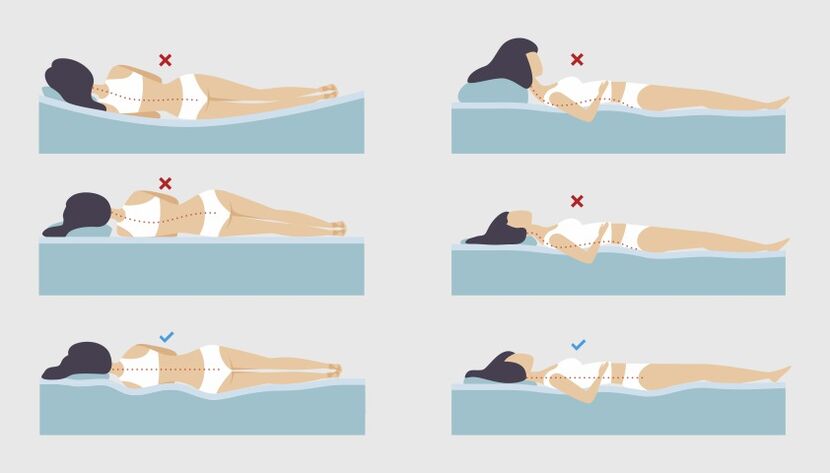
The diagnosis of "neck osteochondrosis" is often made when a person complains of neck pain. Some people also attribute dizziness, memory loss, numbness in the hands and other unpleasant symptoms to this. They mistakenly believe that the disease is due to wear and tear of the intervertebral discs and other elements of the spinal column. associated deformation.
How does the cervical spine work?
The cervical region consists of 7 vertebrae. Between them are intervertebral discs - semi-rigid structures with a dense ring around the perimeter and a jelly-like center that act as shock absorbers. There are two joints to the right and left of each vertebra, between which the cartilage-covered surfaces of the vertebral processes protrude. The joints are connected by the ligaments and muscles of the back.
Why does neck pain occur?
Neck pain typically occurs as a result of awkward movement, injury, or inflammation of any structure of the cervical spine. In addition, pain can be caused by overstretching muscles or ligaments, for example, when lifting weights, unsuccessfully turning the head, or against the background of arthrosis of the joints between the articular processes. "Nerve entrapment" or cervical radiculopathy, specific processes (metastases, vertebral tumors, spinal cord membranes in the neck region) are relatively rare.
26% of men and 40% of women over the age of 30 have experienced neck pain in the past month, and 5% of men and 7% of women experience it regularly.
Acute neck pain usually goes away on its own within 1-2 weeks. In most cases, chronic pain occurs due to a lack of physical activity or, on the contrary, too intense training.
However, people often mistakenly refer to unexplained pain and discomfort as cervical osteochondrosis, associating its development with wear and age-related deformation of the intervertebral discs and other elements of the spinal column. But such pain usually has nothing to do with true osteochondrosis.
Cervical osteochondrosis
According to the International Classification of Diseases (ICD), osteochondrosis (osteochondropathy) is a group of rare hereditary diseases that disrupt the normal development and growth of bones. Osteochondrosis usually begins in childhood and is severe: the joint or part of the bone is deformed and sometimes dies. In this disease, the thoracic spine (lower thoracic vertebrae) is most often affected, rather than the cervical spine. Therefore, the main clinical manifestation of osteochondrosis is the pronounced curvature of the thoracic spine, the so-called thoracic kyphosis.
Symptoms associated with damage to the thoracic spine:
- shortness of breath,
- constant weakness
- inability to breathe completely
- pain and burning sensation behind the sternum,
- attacks of rapid heartbeat.
Conditions with neck pain
Cervical calcification
In people over 50, neck pain is usually caused by cervical spondylosis, the age-related wear and tear of the vertebrae and related structures. In this disease, the intervertebral discs dry out and flatten, which aggravates the depreciation of the neck region, and many movements are accompanied by pain.

But as we age, changes in the spine are normal. Thus, its structures begin to wear out after an average of 30 years, and by the age of 60, 9 out of 10 people already suffer from cervical spondylosis. However, most people are asymptomatic.
Other reasons
Less commonly, neck pain is caused by hypothermia or severe stress, herniated discs, or abnormalities of the cervical vertebrae—bony growths (spurs) that compress nerves that extend from the spinal cord.
The most common source of pain in the cervical spine and shoulder girdle is excessive tension (protection) of the muscles: trapezius, long back muscles of the cervical spine.
In addition, the muscles of the cervical spine are closely connected to the aponeurosis - a wide tendon plate that covers the head. The muscle elements of the aponeurosis in the occipital, temporal and frontal regions are connected to the muscles of the neck region, so neck pain is often associated with headaches. Thus, neck pain accompanied by headache occurring after prolonged sitting work or sleeping in an uncomfortable position is in most cases associated with lack of physical activity and incorrect posture, and is not dangerous to health.
The phenomenon of tech neck, the so-called techno-neck or neck of the Internet era, is associated with pain resulting from an uncomfortable posture. Techneck is the result of constant computer and smartphone use, which forces a person to bend their neck. The fact is that the relative mass of the head increases with forward tilt. Thus, in an "upright" position, the average weight of an adult's head is 5 kg. If the head is tilted forward by at least 15°, the load on the neck muscles is 13 kg, 30°-20 kg, 60°-30 kg. microtraumas, inflammations, fibrosis (overgrowth of connective tissue) and, accordingly, pain may occur.

Causes contributing to the development of degenerative changes of the cervical spine
The onset of pain in the cervical spine is facilitated by birth or any other injury to the spine, developmental disorders, posture disorders, muscle dystonia, as well as prolonged immobilization, obesity and some autoimmune diseases.
- Long-term immobilization is a condition in which a person is forced to lie down for more than a month due to an underlying disease. As a result, the muscles are weakened - and during the vertical formation, when the load increases, they are overstretched. Pain occurs.
- Obesity: Being overweight increases the stress on the spinal structures and can cause pain.
- Autoimmune diseases in which cartilage tissue is destroyed (autoimmune arthritis, polychondritis) also lead to neck pain.
Stages of degenerative changes of the cervical spine
There are 4 main stages of degeneration (destruction) of the cervical spine:
- Section I: the intervertebral discs become thinner, a slight discomfort occurs in the neck area;
- section II: the intervertebral discs are deformed, the distance between the vertebrae decreases. The pain increases with movement of the cervical spine;
- section III: cartilages and vertebrae rub against each other, neck pain becomes constant, movements are limited. In the case of very severe deformations of the cervical spine, vertebral artery syndrome may occur with visual and vestibular disturbances, headaches;
- Section IV: the degenerative changes are pronounced, the movements of the cervical spine are very limited and painful. The neck area can be almost completely immobilized.
Symptoms of degenerative changes in the cervical spine
Most people with cervical osteochondrosis experience chronic pain and neck stiffness. As the disease progresses, other symptoms may appear (especially if the spinal roots, vertebral artery, and adjacent nerve plexuses are compressed).
Symptoms of degenerative changes of the cervical spine:
- neck pain that worsens with movement or standing;
- pain radiates to the shoulder or arm;
- numbness, tingling, and weakness in the arms and hands;
- clicking or grinding in the neck (especially when turning the head);
- headache;
- attacks of vertigo;
- movement coordination disorder;
- loss of bladder or bowel control.
If such symptoms appear, you should consult a neurologist as soon as possible.
Types of symptoms of "neck osteochondrosis".
All the symptoms of "neck osteochondrosis" can be conditionally classified into 3 groups or syndromes: vertebral, radicular and vertebral artery syndrome.
Symptoms of vertebral (spine) syndrome:
- crackling in neck when moving;
- limited mobility;
- violation of the location of the vertebrae relative to each other in the neck;
- smoothing of natural cervical lordosis or lateral curvature in the cervical spine (visible only on X-ray, MRI or CT).
Symptoms of radicular syndrome:
- numbness of the fingers on one or both hands;
- shooting, burning pain in neck, radiating to arm or both arms;
- dystrophy of the neck and arm muscles.
Symptoms of vertebral artery syndrome:
- paroxysmal dizziness, up to loss of consciousness;
- sudden jumps in blood pressure;
- noise in the ears;
- blurred vision or spots in the eyes;
- loss of balance and nausea when moving the head;
- headache (severe pain on one or both sides).
Diagnosis of degenerative changes of the cervical spine
In order to understand the cause of neck pain and establish a diagnosis of "degenerative changes of the cervical spine" (generally known as cervical osteochondrosis), the doctor must perform an examination, study the medical history, and evaluate the results of laboratory and instrumental tests.
Cervical osteochondrosis is diagnosed and treated by a neurologist.
Control
During the examination, the doctor listens to the patient's complaints, clarifies the details of the medical history and performs an examination: he checks reflexes, muscle strength, sensitivity, and the condition of the vestibular apparatus.
In the case of "neck osteochondrosis", muscle atrophy (muscle loss), reduced or increased muscle tone of the long back muscles, and static disorders of the neck region can be seen. When palpating the muscles, the person complains of pain, when tilting the head, the pain may radiate to the head or arms. , dizziness, headache may occur.
In addition, patients may experience movement disorders in the hands (weakness), vision and hearing problems.
The doctor may ask the patient to walk, stand on one leg with the eyes closed, or touch the nose. In this way, the specialist can assess whether movement coordination is not damaged, whether there are problems with gross and fine motor skills.
Laboratory diagnostics
In order to assess the general state of the bones, patients with suspected cervical osteochondrosis are prescribed a blood test for total and ionized calcium, as well as markers of bone tissue growth and destruction - osteocalcin and osteoprotegerin, alkaline phosphatase.
In progressive cervical osteochondrosis, the joints are destroyed, the calcium content may decrease, and osteocalcin and osteoprotegerin, on the contrary, increase.
Total creatine kinase is also considered a marker of muscle tissue destruction in cervical myositis.
In addition, the doctor must assess the blood level of microelements involved in the regulation of muscle tone: magnesium, potassium, sodium.
Instrumental diagnostics
In order to determine the cause of neck pain and related disorders, imaging studies are necessary: X-ray of the cervical spine, computed tomography and magnetic resonance imaging, electroneuromyography.
- Radiography.With the help of X-rays, you can identify bone deformations, malignant tumors and degenerative changes in the joints.
- Computer and magnetic resonance imagingit should be performed when pathology of the spinal column, spinal cord or brain is suspected. Computed tomography shows hemangiomas of the vertebral bodies and gross deformations of the cervical spine. Magnetic resonance imaging is more informative for visualization of muscles, roots and spinal cord.
- Electroneuromyography- a method for studying the efficiency of impulse transmission along a nerve fiber with a low-intensity electric current. The test may be slightly uncomfortable. The examination helps clarify the conduction of impulses from the roots, nerves and nerves to the muscles, confirms the damage to the nerves or muscles, and clarifies the nature and extent of the damage.
Treatment of degenerative changes of the cervical spine
The main goal of treating degenerative changes of the cervical spine is to relieve pain, prevent compression of the cervical nerves, and restore neck mobility.

Depending on the severity of the condition, the doctor may prescribe medications, physical therapy, or massage. Surgery may be necessary if nerves are pinched or joints are deformed.
Drug treatment of degenerative changes of the cervical spine
Neck pain can be alleviated with medication.
Medicines to relieve neck pain and stiffness:
- local anesthetic ointments, gels and patches;
- non-steroidal anti-inflammatory drugs;
- hormonal drugs in the form of tablets or injections in the area of the affected joint;
- muscle relaxants to relieve muscle spasms;
- antidepressants to relieve chronic pain.
Non-pharmacological treatment of cervical osteochondrosis
In addition to drug therapy, it is important for patients with cervical osteochondrosis to perform neck exercises. For this purpose, the person concerned is referred to a physiotherapist for consultation. It teaches you how to properly stretch and strengthen your neck and shoulder muscles.
Your doctor may recommend mats or rollers with metal or plastic needles. It is used for 15-30 minutes before going to bed to relax the muscles.
Wearing the Shantz splint (neck brace) is passive exercise therapy for the deep muscles of the neck region, which are difficult to influence with exercise. When a person puts on a splint, the muscles relax, and when they take it off, they tense. If you wear a splint for 15-20 minutes several times a day, you can train and strengthen it.
It only makes sense to wear it for 2-3 hours if you have severe neck injuries. Moreover, you should not lie in it, let alone sleep.
Surgical treatment of degenerative changes of the cervical spine
Surgery is usually required in patients with severe spinal deformity where the nerve is pinched.
During the operation, the surgeon removes the pathological elements (hernial protrusions, formations, etc. ) or part of the vertebra. After such treatment, a long rehabilitation period is necessary: wearing a Shants splint or a rigid splint for the cervical spine, physical therapy, regular walking, painkillers.
Complications and consequences of degenerative changes of the cervical spine
Without treatment, the intervertebral discs gradually wear out and the vertebrae are "erased".
Common complications of degenerative changes of the cervical spine:
- intractable pain syndrome in the head, neck, chest;
- convulsions, movement disorders and numbness of the hands;
- frequent dizziness, movement coordination, disturbance of fine and gross motor skills.
Prevention of degenerative changes of the cervical spine ("cervical osteochondrosis")
True cervical osteochondrosis has no specific prevention, as it is a hereditary disease.
In order to avoid the appearance of non-specific neck pain, which is mistakenly associated with cervical osteochondrosis, it is important to ensure correct posture and physical activity: the more a person moves, the better the condition of muscles, bones, ligaments and joints.
To maintain physical activity, adults need 150 minutes of moderate-intensity aerobic activity per week. It is suitable for brisk walking, swimming, cycling, tennis, dancing or roller skating. Pilates and yoga strengthen muscles.
In addition, gymnastics helps to avoid overloading the neck muscles and the appearance of pain: tilting the head back and forth, alternating with each shoulder and turning, and sleeping on an orthopedic pillow.
Injuries to the cervical spine must be avoided: do not jump into the water upside down, fasten your seat belt in the car (to prevent whiplash in the event of an accident).

Sleeping position for back pain
Neck and back pain, often attributed to osteochondrosis, can be the result of an uncomfortable sleeping position.
While sleeping, the head and spine should be approximately at the same level. This position minimizes additional pressure on the neck area.

If you mainly sleep on your back, the height of the pillow should be 6-11 cm on average. For side sleepers, the pillow should be thicker: 9-13 cm. Thus, the desired angle of inclination must be kept between the shoulders and the head, the cervical spine does not sag, and the muscles are stretched to compensate for the discomfort.
Moreover, the greater the weight of the person, the higher the pillow should be. You should also pay attention to the hardness of the mattress. The softer it is, the more it sags under the weight of the body, and the higher the pillow should be. In addition, it is better not to always sleep on one side - this leads to muscle imbalance.
If someone prefers to sleep on their stomach, they may suffer from back and neck pain more often. The fact is that it is difficult to keep the spine in a neutral position in this position. To relieve back tension, you can put a pillow under your pelvis and lower abdomen, and you can choose a flat pillow under your head, or you can even sleep without it.
You can also use a special orthopedic pillow.
F. A. Q
- Where can pain radiate from "neck osteochondrosis"?
Pain resulting from degenerative changes in the cervical spine may radiate to the shoulder or arm and may be aggravated by movement or standing.
- How to relieve an attack of dizziness with "neck osteochondrosis"?
To relieve dizziness, you need to take a comfortable position in which the probability of falling is minimal (sit on a chair with a back or lie down) and call for help. After 5-7 minutes, you can try to turn your head: the dizziness will probably go away during this time. If dizziness persists or worsens, nausea, vomiting or other neurological symptoms (speech, vision, movement, swallowing, sensitivity) occur, an ambulance should be called as soon as possible.
- How to sleep properly with "neck osteochondrosis"?
While sleeping, the head and spine should be approximately at the same level. This position minimizes additional pressure on the neck area.
- How long does the "osteochondrosis" of the cervical spine get worse?
On average, the worsening of symptoms due to degenerative changes of the cervical spine ("neck osteochondrosis") lasts an average of 4-7 days. Nonsteroidal anti-inflammatory drugs and muscle relaxants are used to reduce pain. During this time, it is best to remain calm and wear a neck brace.
- Which doctor treats "osteochondrosis" of the cervical spine?
The diagnosis and treatment of pain in the neck region is carried out by neurologists, neurosurgeons, orthopedists and general practitioners.
















































